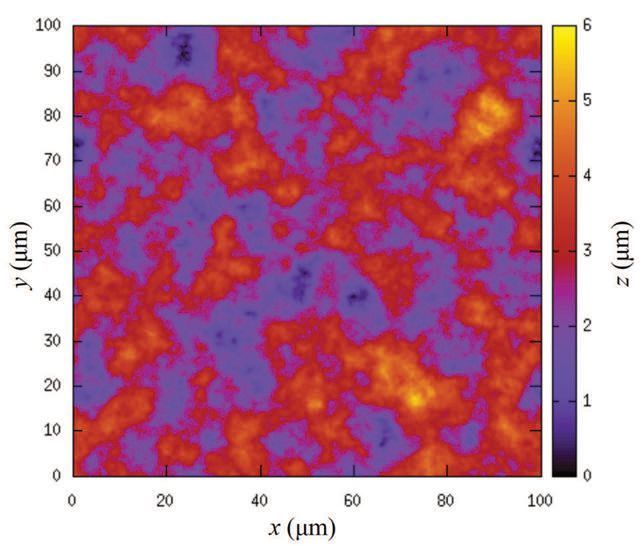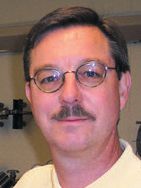Contact-mechanics challenge
Drs. Wilfred T. Tysoe & Nicholas D. Spencer | TLT Cutting Edge December 2015
Modelers of contact mechanics take a leaf from the book of their colleagues in protein structure prediction.
A REGULARLY OCCURRING TOPIC IN THESE COLUMNS has been the
contact conundrum (i.e., what is the real area of contact between two rough surfaces). Next year will mark the 50th anniversary of the publication of the first solution to this problem: the classic paper by Greenwood and Williamson (
1), which invoked an exponential distribution of asperity heights in order to account for the linearity of contact area as a function of normal load whether the contact is plastic or elastic.
Since that work, there have been many further attempts to describe quantitatively the contact of rough surfaces, such as those using fractal theory (
2). Unfortunately, since the direct measurement of contact area between rough surfaces is extremely challenging, there has been no direct experimental verification of any of these models. In other words, we simply do not know which of the many models best describes the real contact situation.
To address this issue, still in the absence of any viable experimental approach, a potential solution is to conduct a
brute-force calculation of real contact area based on a Greens-function, molecular-dynamics method that involves fine discretization of the surface region (in other words, essentially a full solution of the behavior of the asperities under load). Such a calculation is beyond the computational capabilities of most institutions. However, Prof. Martin Müser of the Institute for Advanced Simulation, Jülich and Saarland University in Saarbrücken, Germany, has the code, the computer and the chutzpah to attempt such a feat. Moreover, he has teamed up with the pioneer in this area, STLE-member Jim Greenwood of Cambridge University, UK, to issue a challenge to the contact-mechanics community: They are to use their theories to tackle a defined contact problem, to which Müser, using his supercomputer, has already produced the brute-force solution. Such challenges involving theory testing are not new in science, and have been carried out previously in the protein-folding community, for example (
3).
For the challenge, Müser has created a surface with a well-defined height distribution (
see Figure 1), which is to be brought into contact with a flat, elastic counterface. His computational result is to be kept secret until the proposed theory-based solutions have been submitted.
 Figure 1. Height profile of the random surface to be used in the contact challenge.
Figure 1. Height profile of the random surface to be used in the contact challenge.
The problem definition including the surface topography (provided in real and in Fourier space) can be found at
www.lms.uni-saarland.de/contact-challenge from Nov. 1, 2015. There one also can find instructions on how participants can submit their results for quantities such as the mean gap or contact stiffness as a function of load, as well as distributions of contact patch size, interfacial stress or interfacial separation at a reference load.
The deadline for the submission of solutions is May 1, 2016. A critical comparison of the submitted results will be written by Müser and Greenwood and published in a special article in Tribology Letters in 2016—the 50th anniversary of the original paper. Any researcher whose work is included in the comparison will naturally be offered coauthorship. We wish everybody concerned much success with this bold venture to solve the contact conundrum once and for all.
FURTHER READING
1.
Greenwood, J.A. and Williamson, J.B.P. (1966), “Contact of nominally flat surfaces,”
Proceedings of the Royal Society of London, Mathematical and Physical Sciences,
A295, pp. 300-319.
2.
Persson, B.N.J. (2014), “On the fractal dimension of rough surfaces,”
Tribol. Lett.,
54, pp. 99-106.
3.
Moult, J., Pedersen, J.T., Judson, R. and Fidelis, K. (1995), “A large-scale experiment to assess protein structure prediction methods,”
Proteins: Structure, Function, and Bioinformatics,
23(3), pp. ii-iv.
 Eddy Tysoe is a Distinguished Professor of Physical Chemistry at the University of Wisconsin-Milwaukee. You can reach him at wtt@uwm.edu
Eddy Tysoe is a Distinguished Professor of Physical Chemistry at the University of Wisconsin-Milwaukee. You can reach him at wtt@uwm.edu.
 Nic Spencer is professor of surface science and technology at the ETH Zurich, Switzerland. You can reach him at nspencer@ethz.ch
Nic Spencer is professor of surface science and technology at the ETH Zurich, Switzerland. You can reach him at nspencer@ethz.ch.
Both serve as editors-in-chief of STLE-affiliated Tribology Letters journal.